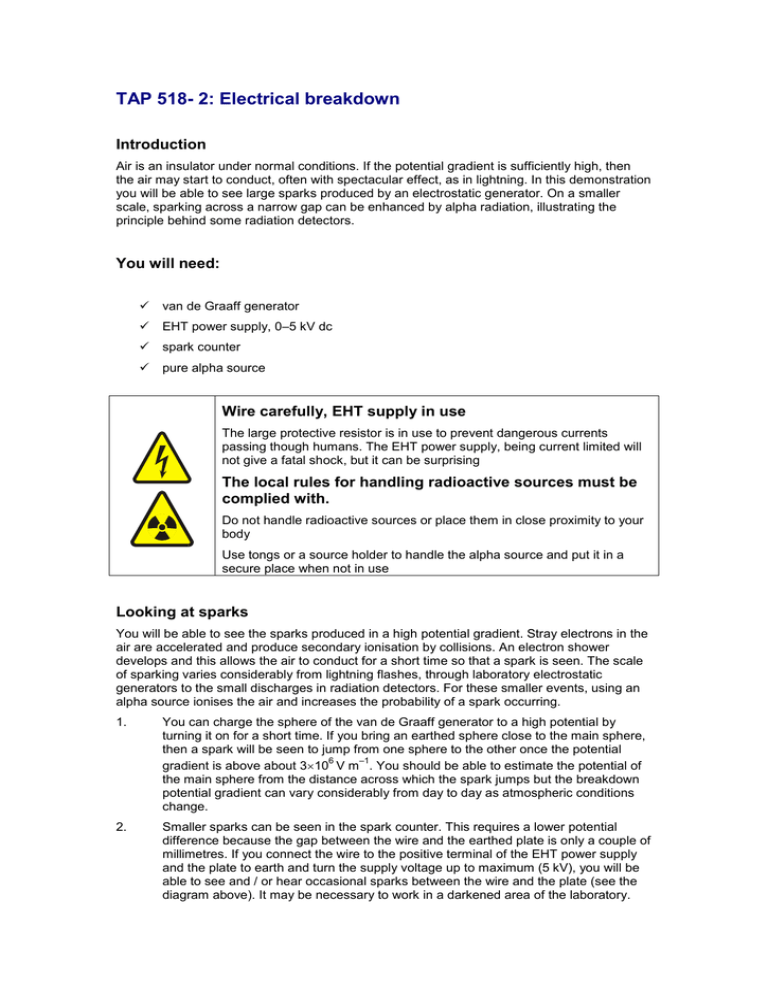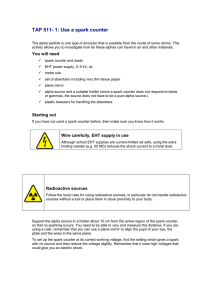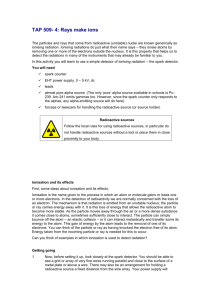Episode 518-2: Electrical breakdown (Word, 61 KB)
advertisement

TAP 518- 2: Electrical breakdown Introduction Air is an insulator under normal conditions. If the potential gradient is sufficiently high, then the air may start to conduct, often with spectacular effect, as in lightning. In this demonstration you will be able to see large sparks produced by an electrostatic generator. On a smaller scale, sparking across a narrow gap can be enhanced by alpha radiation, illustrating the principle behind some radiation detectors. You will need: van de Graaff generator EHT power supply, 0–5 kV dc spark counter pure alpha source Wire carefully, EHT supply in use The large protective resistor is in use to prevent dangerous currents passing though humans. The EHT power supply, being current limited will not give a fatal shock, but it can be surprising The local rules for handling radioactive sources must be complied with. Do not handle radioactive sources or place them in close proximity to your body Use tongs or a source holder to handle the alpha source and put it in a secure place when not in use Looking at sparks You will be able to see the sparks produced in a high potential gradient. Stray electrons in the air are accelerated and produce secondary ionisation by collisions. An electron shower develops and this allows the air to conduct for a short time so that a spark is seen. The scale of sparking varies considerably from lightning flashes, through laboratory electrostatic generators to the small discharges in radiation detectors. For these smaller events, using an alpha source ionises the air and increases the probability of a spark occurring. 1. You can charge the sphere of the van de Graaff generator to a high potential by turning it on for a short time. If you bring an earthed sphere close to the main sphere, then a spark will be seen to jump from one sphere to the other once the potential 6 –1 gradient is above about 310 V m . You should be able to estimate the potential of the main sphere from the distance across which the spark jumps but the breakdown potential gradient can vary considerably from day to day as atmospheric conditions change. 2. Smaller sparks can be seen in the spark counter. This requires a lower potential difference because the gap between the wire and the earthed plate is only a couple of millimetres. If you connect the wire to the positive terminal of the EHT power supply and the plate to earth and turn the supply voltage up to maximum (5 kV), you will be able to see and / or hear occasional sparks between the wire and the plate (see the diagram above). It may be necessary to work in a darkened area of the laboratory. These sparks are initiated by stray electrons or ions passing close to the gap between the wire and the plate. Radioactive source and holder held by tongs 0V + 5000 V gauze sparking here thin wire 3. Alpha particles produce a high density of ionisation along their path. If you hold a source a short distance (2 or 3 cm) from the wire, there will be a considerable increase in the rate of sparking because the additional electrons are likely to produce secondary ionisation leading to breakdown. Many radiation detectors use this as a way of detecting particles. You have seen 1. How sparks can be produced in a strong electric field and how this can be used in radiation detectors. Practical advice If students have not seen the sparks produced by a laboratory electrostatic machine, then they should now. The demonstration of the small discharges in a spark detector follows naturally and links well with the discussion of the fields found in Geiger–Müller tubes. Commercial spark gaps are available, and are less likely to give shocks, but they are expensive. (Some schools may have a spark counter but not recognise it.) TAP 509-4: Rays make ions Episode 519: Particle detectors Social and human context Lightning has a place in discussions of extreme weather conditions on Earth and on other planets. Discharges from overhead power lines can be a reason for energy loss as well as a potential hazard. Wire carefully, EHT supply in use The large protective resistor is in use to prevent dangerous currents passing though humans. The EHT power supply, being current limited will not give a fatal shock, but it can be surprising The local rules for handling radioactive sources must be complied with. Do not handle radioactive sources or place them in close proximity to your body Use tongs or a source holder to handle the alpha source and put it in a secure place when not in use External reference This activity is taken from Advancing Physics chapter 16, 180D



